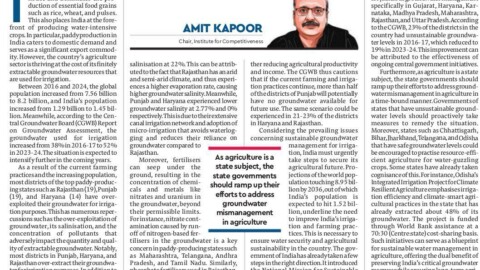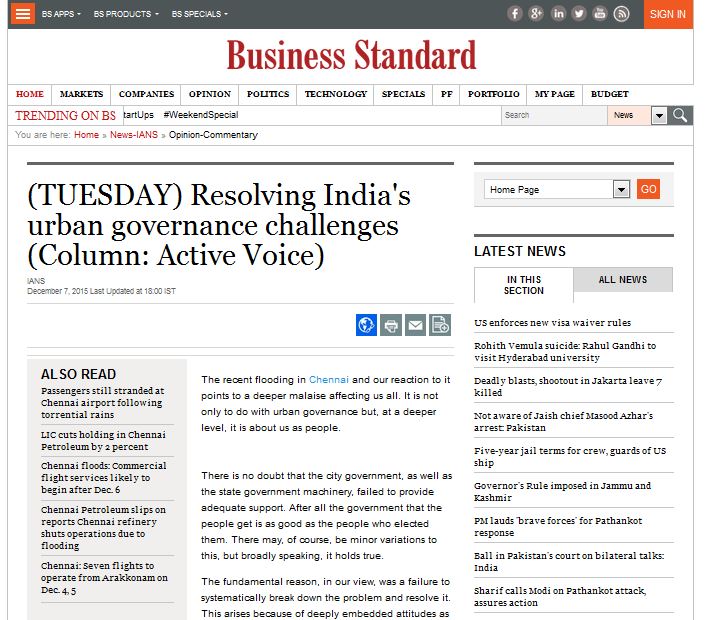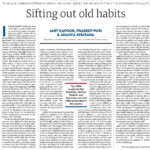India is being watched closely, discussed, and seen as an inspiration across the world as it transforms itself into an economic powerhouse. The transformation we have seen in the last few decades is significant as we move from an image of a nation stuck in the poverty trap, poor infrastructure and corruption to a country that inspires and has ambitions to transform and impact the quality of life of its citizens and becoming a developed nation by 2047. The transformation is yet a long way to go as the country faces significant challenges of job growth and meaningful engagement of citizens. In order to holistically address this challenge, what India needs is a new conceptualization and understanding of its competitiveness and a clear understanding of the advantage it has that can drive its continued growth and prosperity.
Competitiveness thinking has the potential to transform the country, addressing challenges it faces and achieving the aspirations the country has. Before we delve deeper into the approach of how India can drive its competitiveness, we need to define competitiveness, thus shedding light on what it is and what it is not. Competitiveness broadly has come to be associated with competitive exchange rates, exports, FDI inflows, higher exports, etc. These are all the factors that look at exports as drivers of success, wherein it binds understanding of competitiveness to a very narrow perspective.
Even so, export success cannot and should not be seen synonymously with competitiveness. Focus on just export-driven growth puts export-oriented sectors at the centre stage. Exports do drive economic growth as an engine of growth, but without equal focus on local & domestic industries and other aspects of the economy, exports do not have the potential to drive a higher standard of living for the broader population. Competitiveness is about performance across sectors. Thus, the focus of policy should be to enhance overall competitiveness and not only focus on exports. The one aspect that is integral to Competitiveness is productivity.
Competitiveness should be seen from the perspective of productivity, as productivity is the key driver of sustained prosperity. The country and its constituents, i.e., states, districts, and cities, become competitive if they allow conditions that make the firms productive. The goal should be to have productive utilisation of resources, i.e., land, labour and capital. For this productive utilisation, it is important to understand that enablers and determinants of productivity are location-specific. What is of paramount importance is that we should assess a region based on its strengths and weaknesses. This disaggregated view helps us have a granular picture for a more nuanced policy focusing towards driving productivity from resources.
In this context, the idea of productivity also needs to be broadened. Typically, productivity is seen as output per input when it emphasises efficiency. The competitiveness view is not about only producing more with fewer inputs but rather how we are able to extract better value from what is produced. Value creation is about focusing on the needs of society.
Individual firms have a crucial role to play in the process of value creation. It is firms that drive productivity and wealth creation hence, the focus should be on how firms become more competitive and how our regions can provide the conditions that drive the competitive advantage for firms. Firms create jobs, and it is the choices of the firms that drive prosperity. The decisions made by the firm have an impact on the country’s productivity. The eventual choice of the firm strategy includes the sectors in which it competes, the business models it follows, efficiency in the production processes, and value addition, it does are the factors that affect the overall productivity and prosperity of a country. Thus, it becomes imperative that policy creates operating conditions that enable firms to extract better returns for the services they provide or products they manufacture. The fundamental process has to be to go beyond labour arbitrage as a strategy and move to the extraction of better value driven by innovation.
The notion of competitiveness emphasises achieving prosperity by focusing on making your available pool of labour productive and unlocking the reserves of potential labour as well. Competitiveness is about improving labour productivity, that is, increasing GDP per employee. India has seen enhanced labour productivity through the adoption of technology and mechanisation. Where India lacks is labour mobilization, which poses a significant challenge for the future. The demographic dividend that is projected to offer the highest working age ratio for the next two decades makes it critical to focus on gainful engagement in decades to come. What matters eventually is how we are able to utilise the labour pool and engage talent in constructive pursuits.
As we understand the robustness of competitiveness as a construct, we must also lay emphasis on understanding the macroeconomic and the microeconomic fundamentals of the nation. The macroeconomic and macroeconomic conditions explain different but complementary aspects of the economy. Microeconomic conditions or aspects look at broad social & political institutions fiscal & monetary policy measures, whereas microeconomic conditions look at factors that directly impact the performance of enterprises and the labour force. A comprehensive view to understand competitiveness should not be missed as a process to make progress on a multitude of policy fronts simultaneously. The idea should be to drive and build an overall agenda for growth that encompasses key policy areas and priority actions
India’s development from a low-income economy to a high-income economy should be driven by new guiding principles that are understood from the lens of competitiveness. We also need to focus on policy priorities with a focus on implementation. As India emerges as a prominent player on the global stage, it has well become a moral responsibility to drive the growth and prosperity of our people. It becomes exceedingly important for India to succeed not only for the sake of its citizens but also for the sake of humanity.
The article was published with Financial Express on October 18, 2023.
(Amit Kapoor is the chair of the Institute for Competitiveness and a Lecturer at Stanford University)























